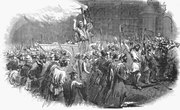Because human beings are social and learn from observation rather than depending entirely on instinct, almost all aspects of human psychology and behavior are socially influenced. Languages, modes of dress, gender roles and avoided taboos are all agreed upon at a group level and form the basis of culture. All cultures vary, and each forms the basis for the attitudes, values and behaviors of its members. These are reinforced by social institutions and collective behavior. Within each culture, other social influences affect the behavior of its members.
Collective Behavior
Collective behavior occurs when large numbers of people engage in a loosely organized activity. These activities can promote or obstruct social change through political activism or protests and can can occur in the potentially destructive forms such as riots. Religious revivals such as the First and Second Great Awakenings and moral panics like the one that lead to the Prohibition Era of the 1920s can also profoundly impact society. The collective behavior of fads tend to influence fashion and consumer behavior without leaving a lasting societal impact. Collective behavior can often result in peer pressure, which compels people to conform to group behavior or risk ostracism. While peer pressure impacts all age groups, adolescents are especially vulnerable to this type of collective behavior.
Religious Organizations
Religious organizations are social groups that promote or forbid behaviors based on a shared set of beliefs. Regular attendance to group functions creates a sense of community and promotes adherence to group beliefs that is reinforced by teachings and the association of specific behaviors with spiritual reward or punishment. Religious groups often establish rules governing sexual behavior, food and interactions with others. In addition, psychologists have found correlations between religious affiliation and higher reported happiness as well as greater levels of self-regulation and self-control.
Mass Media
Mass media is a powerful tool to influence the attitudes and behavior of those who consume it. Commercial advertising, for example, uses tactics that encourage bandwagoning (the desire to be part of a group) and feelings of nostalgia to manipulate consumer activity. During elections, political advertisements and network campaign coverage influence voters and impact the political process. Decisions that news organizations make regarding how to present facts and what stories to broadcast can also impact voter attitudes toward a political issue or candidate.
Family
Family interaction has a profound impact on an individual's childhood and adult behavior. Studies from institutions such as the University of Washington and North Carolina State University show that disciplinary methods, parental involvement and parental attitudes toward emotion can influence a child's social ability and behavior as well as the possibility of delinquent or criminal behavior. Language, social norms and moral values are all also acquired through early family interaction and influence behavior for an individual's lifetime.
Related Articles
References
- Trinity University: A Sociological Social Psychology: Collective Behavior and the Social Psychologies of Social Institutions
- Psychological Bulletin: Religion, Self-Regulation, and Self-Control: Associations, Explanations, and Implications
- Illinois Wesleyan University: The Effects of Family, Social and Background Factors on Children's Educational Attainment
- University of Washington: Family Dynamics Through Childhood: A Sibling Model of Behavior Problems
- Aspen Education Group: Peer Pressure
Writer Bio
Agatha Clark is from Portland, Ore., and has been writing about culture since 2001. She specializes in intercultural communication and is completing a Bachelor Arts at the University of Oregon with double majors in linguistics and Spanish. Clark is fascinated by expressions of human psychology and culture. Before refocusing her educational path toward language, she originally went to school to become an artist.











